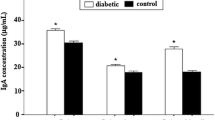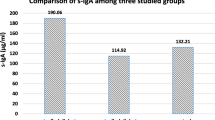Abstract
This study investigated the effects of diabetes mellitus (types I and II) on human salivary gland function compared to healthy age-matched controls. The results have shown that both type I and type II diabetic patients secrete significantly (p < 0.05) less resting and stimulated saliva compared to healthy age-matched controls (AMC). It was also found that the diabetic patients have an increased resting and stimulated salivary protein concentration compared to healthy participants. However, the secretory capacity (stimulated minus resting values) was markedly reduced compared to controls. The level of calcium (Ca2+) in the saliva of diabetic patients was significantly (p < 0.05) elevated compared to the AMC. In contrast, the levels of magnesium (Mg2+), zinc (Zn2+) and potassium (K+) in the saliva of diabetic patients were significantly (p < 0.05) reduced compared to the values obtained in AMC. These results indicate that diabetes mellitus can lead to marked dysfunction of the secretory capacity of the salivary glands. In these patients a modified fluid, organic and inorganic salivary secretion may be responsible for the increased susceptibility to oral infections and impaired wound healing described by others in the literature. (Mol Cell Biochem 261: 137–142, 2004)
Similar content being viewed by others
References
Mandel ID: Salivary diagnosis: More than a lick and a promise. J Am Dent Assoc 124: 85–87, 1993
Pellerin C, Pellat B: La salive. In: Biochimie Odonto Stomatologique. Masson, Paris 1986, pp 33–54
Kaufman E, Lamster IB: The diagnostic applications of saliva—a review. Crit Rev Oral Biol Med 13(2): 197–212, 2002
Drobitch RK, Svensson CK: Therapeutic drug monitoring in saliva. An update. Clin Pharmacokinet 23: 365–379, 1992
Fox PC: Salivary monitoring in oral diseases. Ann NY Acad Sci 694: 234–237, 1993
Davies PB: Pathophysiology of cystic fibrosis with emphasis on salivary gland involvement. J Dent Res 66: 667–671, 1987
Samuel NM, Chandrasekaran A, Paul SA: Detection of antibodies to HIV-1 in serum and saliva. J Assoc Physicians India 45(4): 280–282, 1997
Daniels TE, Fox PC: Salivary and oral components of Sjögren's syndrome. Rheum Dis Clin North Am 18: 571–589, 1992
Nechifor M, Teslariu E, Mindreci I, Mihailovici S, Matei V, Filip C, Miftode M, Danila GH: The influence of magnesium, chromium and copper in alloxan-induced diabetic rats. In: Advances in Magnesium Research Nutrition and Health. Y. Rayssiguier, A. Mazur, J. Durlach (eds). John Libbey, London, 2001, pp 375–379
Twetman S, Johansson I, Birkhed D, Nederfors T: Caries incidence in young type 1 diabetes mellitus patients in relation to metabolic control and caries-associated risk factors. Caries Res 36(1): 31–35, 2002
Chavez EM, Borrell LN, Taylor GW, Ship JA: A longitudinal analysis of salivary flow in control participants and older adults with type 2 diabetes. Oral Surg Oral Med Oral Pathol Oral Radiol Endod 91(2): 166–173, 2002
Navazesh M: Salivary gland hypofunction in ederly patients. J Calif Dent Assoc 22: 62–68, 1992
Lowry OH, Roseborough NJ, Forr AL, Randall RJ: Protein measurement with folin phenol reagent. J Biol Chem 193: 265–275, 1951
Markopoulos AK, Belazi M: Histopathological and immunohistochemical features of the labial salivary glands in children with type 1 diabetes. J Diabetes Complications 12: 39–42, 1998
Ship JA, Pillemer SR, Baum BJ: Xerostomia and the geriatric patient. J Am Geriatr Soc 50(3): 535–543, 2002
Oxford GE, Tayari L, Barfoor MD, Peck AB, Tanaka Y, Humphreys-Beher MG: Salivary EGF levels reduced in diabetic patients. J Diabet Complications 14: 140–145, 2000
Belce A, Uslu E, Kucur M, Umut M, Ipbuker A, Seymen HO: Evaluation of salivary sialic acid level and Cu-Zn superoxide dismutase activity in type 1 diabetes mellitus. Tohoku J Exp Med 192(3): 219–225, 2000
Tosiello L: Hypomagnesemia and diabetes mellitus. Arch Int Med 156: 1143–1148, 1996
Leeuw ID: Magnesium and diabetes: Is magnesium depletion a risk factor for complications in type 1 diabetic patients. In: Advances in Magnesium Research Nutrition and Health. Y. Rayssiguier, A. Mazur, J. Durlach (eds). John Libbey, London, 2001, pp 369–374
Mata AD, Marques D, Geraldes M, Rocha S, Mesquita MF, Singh J: Acetylcholine evoked salivary secretion: Role of extracellular magnesium on acetylcholine evoked secretory responses in the isolated rat submandibular cell glands. In: Advances in Magnesium Research Nutrition and Health. Y. Rayssiguier, A. Mazur, J. Durlach (eds). John Libbey, London, 2001, pp 93–96
Yago MD, Mata AD, Mañas M, Singh J: Effect of extracellular magnesium on nerve mediated and acetylcholine-evoked secretory responses in the isolated rat parotid gland. Exp Physiol 87(3): 321–326, 2002
Jin Y, Hak-Kong H: Supragengival calculus: Formation and control. Crit Rev Oral Biol Med 13(5): 426–441, 2002
Author information
Authors and Affiliations
Rights and permissions
About this article
Cite this article
Mata, A.D., Marques, D., Rocha, S. et al. Effects of diabetes mellitus on salivary secretion and its composition in the human. Mol Cell Biochem 261, 137–142 (2004). https://doi.org/10.1023/B:MCBI.0000028748.40917.6f
Issue Date:
DOI: https://doi.org/10.1023/B:MCBI.0000028748.40917.6f




